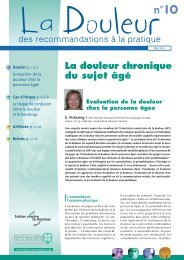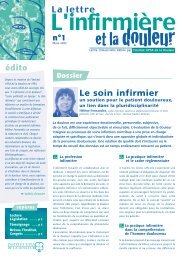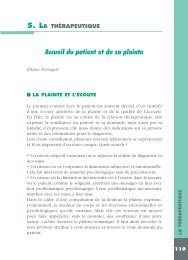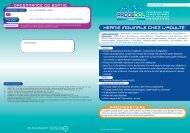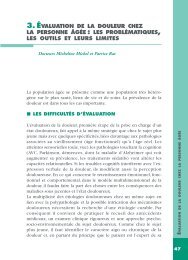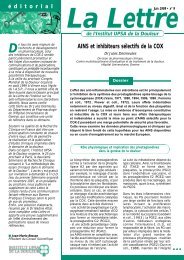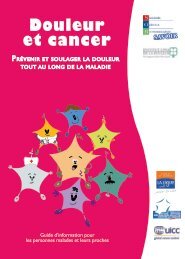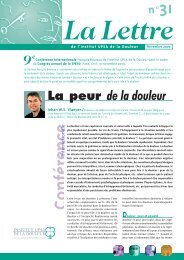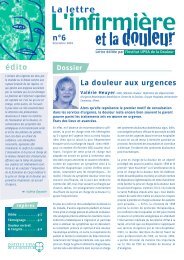Procedol : Gastrotectomie - Institut upsa de la douleur
Procedol : Gastrotectomie - Institut upsa de la douleur
Procedol : Gastrotectomie - Institut upsa de la douleur
You also want an ePaper? Increase the reach of your titles
YUMPU automatically turns print PDFs into web optimized ePapers that Google loves.
paracétamol 1 g poet/ouORDONNANCE DE SORTIEantalgique <strong>de</strong> niveau 2Références bibliographiques1 g x 4/j pendant 2-4 j• Paracétamol (400-500 mg) + [codéine (20-30 mg)ou <strong>de</strong>xtropropoxyphène (30 mg)] : 1-2 cp ou gél./8hou• Tramadol (50 mg) : 1-2 gél. x 4/jÉTABLISSEMENT1. Kitano S, et al. A randomized controlled trial comparing open vs <strong>la</strong>paroscopy-assisted distal gastrectomy for the treatment of early gastric cancer: an interimreport. Surgery. 2002 ; 131 : S306-11.2. Meyer Ch, et al. French Association of Surgery. Gastric cancer: the French survey. Acta Gastroenterol Belg. 2002;65:161-5.3. Aida S, et al. Preemptive analgesia by intravenous low-dose ketamine and epidural morphine in gastrectomy: a randomized double-blind study. Anesthesiology. 2000 ; 92 : 1624-30.4. Adachi Y, et al. Review of the Japanese experience. Dig. Surg. 2002 ; 19 : 333-9.5. Mann C, et al. Comparison of intravenous or epidural patient-controlled analgesia in the el<strong>de</strong>rly after major abdominal surgery. Anesthesiology. 2000 ; 92 : 433-41.6. Pouzeratte Y, et al. Patient-controlled epidural analgesia after abdominal surgery: ropivacaine versus bupivacaine. Anesth. Analg. 2001 ; 93 : 1587-92,7. Wiebalck A, et al. The effects of adding sufentanil to bupivacaine for postoperative patient-controlled epidural analgesia. Anesth. Analg. 1997 ; 85 : 124-9.8. Aida S, et al. The effectiveness of preemptive analgesia varies according to the type of surgery: a randomized, double-blind study. Anesth. Analg. 1999 ;89 : 711-6.9. Moiniche S, et al. A qualitative and quantitative systematic review of preemptive analgesia for postoperative pain relief: the role of timing of analgesia.Anesthesiology. 2002 ; 96 : 725-41.10. Tang J, et al. Effect of parecoxib, a novel intravenous cyclooxygenase type-2 inhibitor, on the postoperative opioid requirement and quality of pain control.Anesthesiology. 2002 ; 96 : 1305-9.11. Guignard B, et al. Supplementing <strong>de</strong>sflurane-remifentanil anesthesia with small-dose ketamine reduces perioperative opioid analgesic requirements.Anesth Analg. 2002 ; 95 : 103-8.12. Schmid RL, et al. Use and efficacy of low-dose ketamine in the management of acute postoperative pain: a review of current techniques and outcomes.Pain. 1999 ; 82 : 111-25.13. Komatsu H, et al. Comparison of patient-controlled epidural analgesia with and without background infusion after gastrectomy.Anesth Analg. 1998 ; 87 : 907-10.14. Komatsu H, et al. Comparison of patient-controlled epidural analgesia with and without night-time infusion following gastrectomy.Br J Anaesth. 2001 ; 87 : 633-5.15. Sveticic G, et al. Combinations of morphine with ketamine for patient-controlled analgesia: a new optimization method. Anesthesiology. 2003 ; 98 : 1195-205.16. Kehlet H, et al. Multimodal strategies to improve surgical outcome. Am J Surg. 2002 ; 183 : 630-41.17. Rigg JR, et al. MASTER Anaethesia Trial Study Group. Epidural anaesthesia and analgesia and outcome of major surgery: a randomised trial.Lancet. 2002 ; 359 : 1276-82.18. Jorgensen H, et al. Epidural local anaesthetics versus opioid-based analgesic regimens on postoperative gastrointestinal paralysis, PONV and pain afterabdominal surgery. Cochrane Database Syst Rev. 2000 ; (4) : CD001893.2540519GASTRECTOMIE *COMITÉ SCIENTIFIQUE : Frédéric Aubrun - Dominique Fletcher - Christian Jayr - Agnès Bel<strong>la</strong>nger - Chantal BernardRÉDACTEURS : Frédéric Aubrun - Marc Beaussier - Anissa Belbachir - Chantal Bernard - Franck Bo<strong>la</strong>ndard - GillesBoccara - Laurent De<strong>la</strong>unay - Nico<strong>la</strong>s Derro<strong>de</strong> - Dominique Fletcher - Elisabeth Gaertner - Olivier Gall - Christian Jayr -Hawa Keita-Meyer - Philippe Macaire - C<strong>la</strong>u<strong>de</strong> Mann - Emmanuel Marret - Olivier Mimoz - Cyrus Motamed - MarcRoucoules-Aimé - Catherine Spielvogel - François StarkDouleur 1,2,3• Douleur postopératoire très intense <strong>de</strong> J1 à J3. Sous morphine péridurale : EVA = 30-80 mmau repos. EVA = 55-100 mm à <strong>la</strong> toux• Douleur postopératoire faible à modérée jusqu'à J7Patient 1,2,4• Âge moyen : 60-70 ans• Altération <strong>de</strong> l'état général dans 40 % <strong>de</strong>s cas• Anémie préopératoire dans 20 % <strong>de</strong>s casChirurgie et réhabilitation 1,2,4Par <strong>la</strong>parotomie (médiane sus ombilicale)• Gastrectomie totale ou subtotale dans 86 % <strong>de</strong>s cas, segmentaire dans 14 % <strong>de</strong>s cas• Durée opératoire : 2-4 h• Saignement peropératoire : 250 ml• Durée d'hospitalisation : 16-17 j (gastrectomie totale)• Son<strong>de</strong> gastrique <strong>de</strong> J1-J3• Réalimentation orale possible à partir <strong>de</strong> J4-J6• Réhabilitation activePar <strong>la</strong>paroscopieSupérieure à <strong>la</strong> <strong>la</strong>parotomie sur :• <strong>la</strong> <strong>douleur</strong> postopératoire (diminution <strong>de</strong> 55 % <strong>de</strong> l'EVA au repos <strong>de</strong> J1 à J3)• le saignement peropératoire (diminution <strong>de</strong> 50 %)mais pas <strong>de</strong> différence sur :• <strong>la</strong> consommation d'analgésiques• le dé<strong>la</strong>i <strong>de</strong> reprise <strong>de</strong> l'alimentation orale• <strong>la</strong> durée d'hospitalisation* Sous <strong>la</strong> responsabilité <strong>de</strong>s auteursPROCEDOL DATE DE DIFFUSION :PROCÉDURES POURLA PRISE EN CHARGEDE LA DOULEURPOSTOPÉRATOIREAvec le parrainage <strong>de</strong> l’
GASTRECTOMIEPROCEDOLBLOC OPÉRATOIRE 6,9PRODUIT/VOIE MODALITÉS POSOLOGIE BÉNÉFICES ATTENDUS REMARQUESLOCORÉGIONALE8,9lidocaïne 2 % Ponction en Dose <strong>de</strong> charge fractionnée Extubation précoce 5adrénalinée T8-T9 (en préop) avant l'induction <strong>de</strong> l'AG :PÉRIDURALECathéter : 4-5 cm 3-8 ml pour un niveaupuis en direction sensitif › T4céphaliqueropivacaïne 0,2 % Perfusion 2-6 ml/h+ sufentanil 1 µg/ml continuePÉRIDURALEpARENTÉRALEparacétamol 1 g iv Perfusion 1 gAnalgésie <strong>de</strong> complémentsur 15 minALTERNATIVES 3,10-12parécoxib40 mg/ml IVkétamine10 mg IV103,11,12PRODUIT/VOIEropivacaïne 0,2 %sufentanil 0,5 µg/mlPerfusionsur 15 min,45 à 60 minavant <strong>la</strong> fin <strong>de</strong>l’interventionBolus puisperfusioncontinuePCEA**PROCÉDURES POURLA PRISE EN CHARGEDE LA DOULEURPOSTOPÉRATOIRE40 mgALTERNATIVES : PARENTÉRALEmorphine 1 mg/ml IVoutramadol100 mg/2 ml IV0,15 mg/kg enpréopératoire puis1-2 µg/kg/min enperopératoireLa périduraleperopératoire n'améliorepas l'analgésiepostopératoirePerfuser 60 min avant<strong>la</strong> fin <strong>de</strong> l’interventionRespecter les contreindicationset les précautionsAnalgésie par anticipationEpargne morphinique d’emploi <strong>de</strong>s AINSMeilleure tolérancepostopératoire <strong>de</strong> 20-40 % digestive mais risquerénal i<strong>de</strong>ntique aux AINSnon sélectifsPrécaution d’emploi encas d’antécé<strong>de</strong>ntscardiovascu<strong>la</strong>iresEpargne morphiniquepostopératoireAbsence d'effetpsychodysleptique àdoses faibles. Effetsanalgésiques dosedépendants.Le rapportbénéfice risque <strong>de</strong>sposologies importantes(si › 1 mg/kg) n'est pasencore c<strong>la</strong>irement établiSSPI 5-9,13,14MODALITÉS POSOLOGIEBÉNÉFICES ATTENDUS REMARQUESLOCORÉGIONALE3 ml/h en continuBolus <strong>de</strong> 2 mlPério<strong>de</strong> réfractaire :12-15 minAnalgésie d’excellentequalité au repos età <strong>la</strong> mobilisationL'addition <strong>de</strong> sufentanilà un anesthésique loca<strong>la</strong>méliore <strong>la</strong> qualité <strong>de</strong>l'analgésie 6,7Titration 3 mg/5-10 min pour obtenir une EVA ‹ 30 mm. Surveil<strong>la</strong>nce continue <strong>de</strong> <strong>la</strong> conscience,fréquence respiratoire et score <strong>de</strong> <strong>la</strong> <strong>douleur</strong>puisPCA*** 1-1,5 mg/bolus, pério<strong>de</strong> réfractaire : 7-8 min, pas <strong>de</strong> dose maximaleL'addition <strong>de</strong> 1 mg <strong>de</strong> kétamine pour 1 mg <strong>de</strong> morphine dans <strong>la</strong> seringue <strong>de</strong> PCA améliorel'analgésie 15Dose <strong>de</strong> charge 2-3 mg/kg (30 min avant <strong>la</strong> fermeture), puis 400-600 mg/jen perfusion continue. Pour les patients qui ne peuvent pas gérer une PCA/PCEAPRODUIT/VOIEropivacaïne 0,2 %+ sufentanil 0,5 µg/mlparacétamol 1 g ivALTERNATIVESmorphine1 mg/ml ivparécoxib40 mg ivparacétamol1 g potramadol50 mg po• CHOIX DE LA TECHNIQUE CHIRURGICALE ET DE LA MÉTHODE ANALGÉSIQUEpermettant une réduction significative <strong>de</strong>s scores <strong>de</strong> <strong>douleur</strong> :1) Laparoscopie et incision transverse 5,82) Analgésie péridurale (AL + morphinique) : EVA diminuée <strong>de</strong> 15-20 mm par rapport au groupe contrôle(le plus souvent PCA morphine ± AINS) 1,3,5,6,8,10,11SECTEUR D’HOSPITALISATION5,6,13,14,16-181510MODALITÉS POSOLOGIEBÉNÉFICES ATTENDUS REMARQUESPCEAPerfusionsur 15 minPCAPerfusionsur 15 minLOCORÉGIONALE3 ml/h en continuBolus <strong>de</strong> 2 mlPério<strong>de</strong> réfractaire :12-15 minPARENTÉRALE1 g x 4/j1-1,5 mg/bolusPério<strong>de</strong> réfractaire : 7-8 minPas <strong>de</strong> dose maximale40 mg x 2/jRELAISAnalgésie d’excellentequalité au repos et à <strong>la</strong>mobilisation, réduction <strong>de</strong><strong>la</strong> durée d’hospitalisation,reprise du transit plusrapi<strong>de</strong>, diminution<strong>de</strong> <strong>la</strong> morbidité respiratoireAnalgésie <strong>de</strong>complémentEpargne morphiniquepostopératoire<strong>de</strong> 20-40 %Re<strong>la</strong>is per os si EVA ‹ 30 mm au repos, et reprise boissons (J4-J5)Systématique 1 g x 4/jAnalgésie continue2 gél. x 4/jEntretien analgésieEntretien analgésie** PCEA : patient controlled epidural analgesia : analgésie épidurale contrôlée par le patient*** PCA : patient controlled analgesia : analgésie contrôlée par le patientAnalgésie auto-contrôléeSurveil<strong>la</strong>nce continue<strong>de</strong> <strong>la</strong> conscience,fréquence respiratoireet score <strong>de</strong> <strong>douleur</strong>L'addition <strong>de</strong> 1 mg <strong>de</strong>kétamine pour 1 mg <strong>de</strong>morphine dans<strong>la</strong> seringue <strong>de</strong> PCAaméliore l'analgésieRespecter les contreindications<strong>de</strong>s AINSMeilleure tolérancedigestive mais risquerénal i<strong>de</strong>ntique aux AINSnon sélectifsDé<strong>la</strong>i d'action : 15-45 minPic d'efficacité : 120 min.Durée d'action : 6 h



